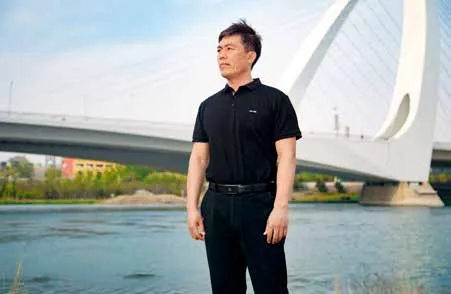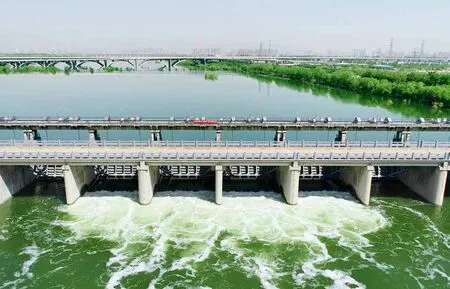Revitalizing Beijing’s Mother River
2022-06-08TextbyHanZhonghua
Text by Han Zhonghua
The Yongding River originates from the Sanggan River in Shanxi Province and the Yanghe River in Inner Mongolia Autonomous Region and flows 750 kilometers through Inner Mongolia, Shanxi, Hebei,Beijing, and Tianjin before emptying into the Bohai Sea in eastern China.It is considered the “mother river” of Beijing and runs 170 kilometers through the municipality.The Yongding River is one of China’s four major flood drainage channels,so Beijing and other cities in the river basin have accumulated rich experiences in emergency flood response.In recent years,impressive achievements in water conservation along the Yongding River through afforestation,pollution prevention and control,environmental improvement,and ecological restoration have been made.
Decades of Efforts
Historically, the Yongding River faced problems like water scarcity, water pollution, and environmental degradation.Beijing implemented a series of comprehensive measures covering water saving, industrial restructuring, coordinated pollutioncontrol, ecological restoration,and water replenishment to reverse the situation.

Han Zhonghua, a senior engineer with Beijing Water Science and Technology Institute, stands on the west bank of Lianshi Reservoir of the Yongding River.by Zhang Ye/China Pictorial

The Yongding River is an important water supply channel and water source protection and replenishment area for Beijing.In recent years,Beijing has vigorously stepped up overall remediation and ecological restoration of the Yongding River.courtesy of Beijing Water Authority
In 1954, five years after the founding of the People’s Republic of China, the Guanting Reservoir, the first large-scale reservoir in the country, was built in the upper reaches of the Yongding River to mitigate the impact of flooding.Over the following decades, embankment reinforcement and improvement of the river’s Beijing section also played an important role in reducing the flood damage.
The Guanting Reservoir supplied drinking water to Beijing until 1997 when water quality of the reservoir deteriorated.In 2004, the Heituwa Wetland was constructed to purify water from the Yongding River before discharged into the reservoir,reducing pollution by 14 percent.In 2019, the Bahaoqiao Wetland was completed at the entrance of the Guanting Reservoir,providing treatment to 260,000 cubic meters of water each day.Now, 100 percent of river water is treated before reaching the reservoir, and the water quality has improved from Class V to Class IV.Cities in the upper reaches of the Yongding River have also made great efforts in water pollution control and ecological restoration.The Guanting Reservoir began supplying drinking water to Beijing again in 2007, and its water quality has maintained Class IV since 2010.
The water diversion project transfers water from the upper reaches of the Yongding River to the country’s drought-prone north.From 2007 to 2018, a total of 308 million cubic meters of water was diverted to Beijing.In 2018, a cooperation agreement on guaranteeing water supply for the Yongding River was signed,requiring that water replenishment from the Yellow River to the Guanting Reservoir happen during dry seasons to keep the volume at least 100 million cubic meters.Under that agreement,the Wanjiazhai Water Project in Shanxi diverted Yellow River water into the Guanting Reservoir three times from the beginning of 2019 to the first half of 2020.

Gates of the river barrage at the Lugou Bridge on the Yongding River open to discharge excess water.The 170-kilometer Beijing section of the Yongding River achieved continuous water flow for the first time in 25 years with the opening of spring season water replenishment to the river on April 20, 2020.courtesy of Beijing Water Authority
In 2019, the Guanting Reservoir spent 87 days supplying 223 million cubic meters of water to the plain section of the Yongding River for the first time to restore the ecology of the lower reaches.In the spring of 2020, another 164 million cubic meters of water was replenished.Since then, 248 kilometers of continuous water channels have been formed below the reservoir.Meanwhile, the river section flowing through mountains and valleys didn’t dry up for the first time in 40 years, while the section flowing through the southern plain enjoyed gurgling water.The river finally reached the Yongding Xinhe Bridge in Tianjin, bringing Beijing, Tianjin,and Hebei a bit closer.
Better Living, Sustainable River Culture
Evidence of prehistoric human activities has been found along the Yongding River.Dozens of Paleolithic and Neolithic archaeological sites have been discovered in the Nihewan Basin along the river, including an ancient human site dating back about two million years ago, the Peking Man site from 770,000 years ago, the Xindong Man remains from 200,000 years ago, the Hilltop Caveman site from 40,000 years ago, and the Donghulin Man ruins from 10,000 years ago.Religious sites were also found in Miaofeng Mountain and Badachu Park along the Yongding River.The Yongding River has nurtured Beijing since ancient times.Historically, Beijing served as the ancient capital of six dynasties and brought the formation and development of the region’s water culture including flood control, irrigation, and ferry and waterway transportation featuring the Yongding River-Xishan Mountains Cultural Belt in western Beijing.
Beijing has accelerated ecological restoration and improvement of the Yongding River since 2009.Lakes, parks,and wetlands were constructed along the river between 2010 and 2013, forming the Yongding River Ecological and Recreational Belt, which now attracts thousands of visitors every day.
In 2017, a four-tier “river chief” system at city, district,township, and village levels was established for the management of the Yongding River.Under the system, illegal barbecue stalls, construction waste heaps,breeding farms, gravel pits,and illegal buildings within the protection area of the Yongding River were banned and reclaimed as green spaces for sightseeing and recreation.In 2017 alone, 67 species of terrestrial plants and 21 aquatic plants were introduced to the urban section of the Yongding River.
According to a plan released in 2016, 37 billion yuan (about US$5.5 billion) was earmarked to promote comprehensive management and ecological restoration of the Yongding River.Since then, Beijing,Hebei, Shanxi, and Tianjin have made concerted contributions to managing and protecting the river, alongside related departments of the central government and local residents.
In its urban development master plan for 2016 to 2030,Beijing pledged to protect the Yongding River-Xishan Mountains Cultural Belt by leveraging unique historical and cultural resources in areas like imperial gardens, Badachu Park, the Yongding River, and Dafangshan Mountain.The Yongding River is gradually emerging as a definitive water route featuring restored ecological functions and rich cultural legacies.
